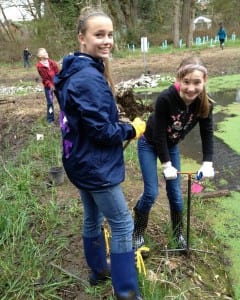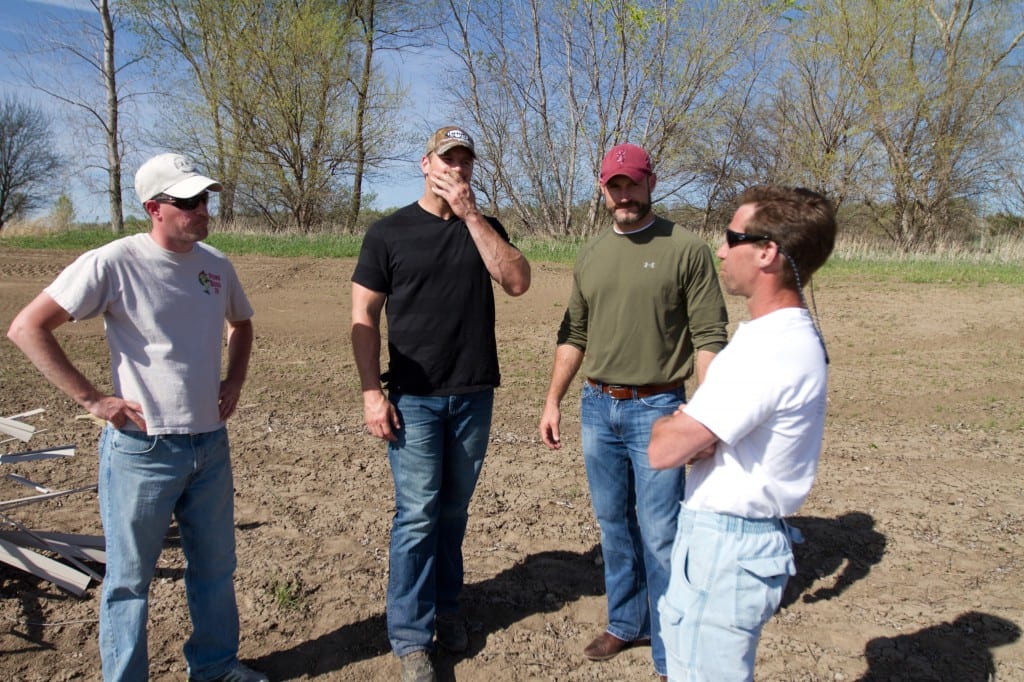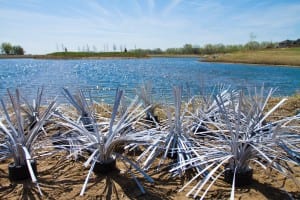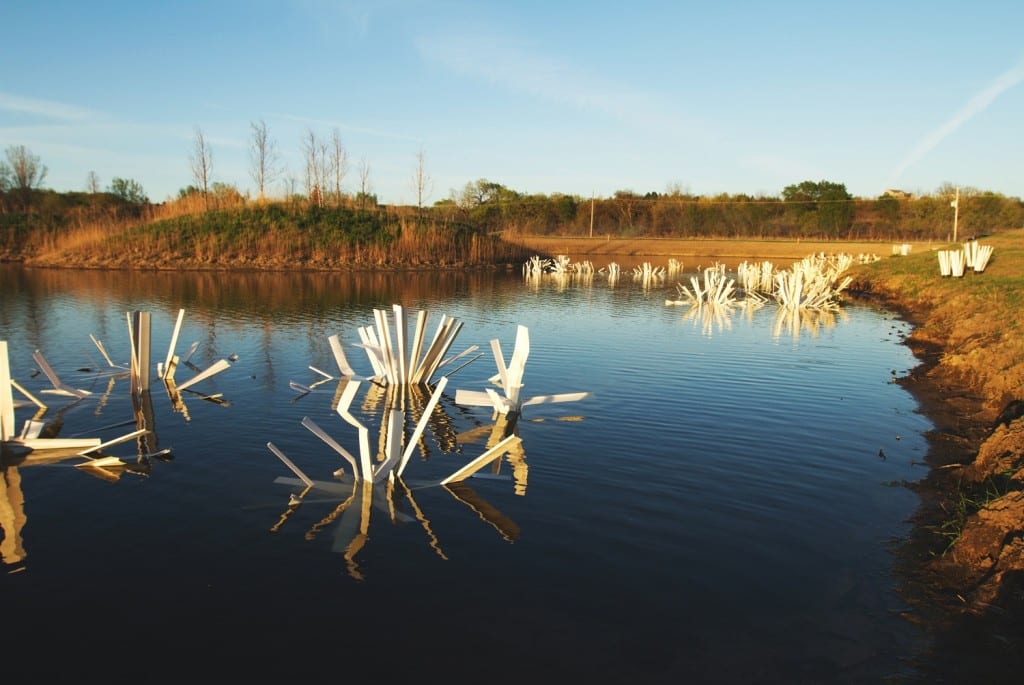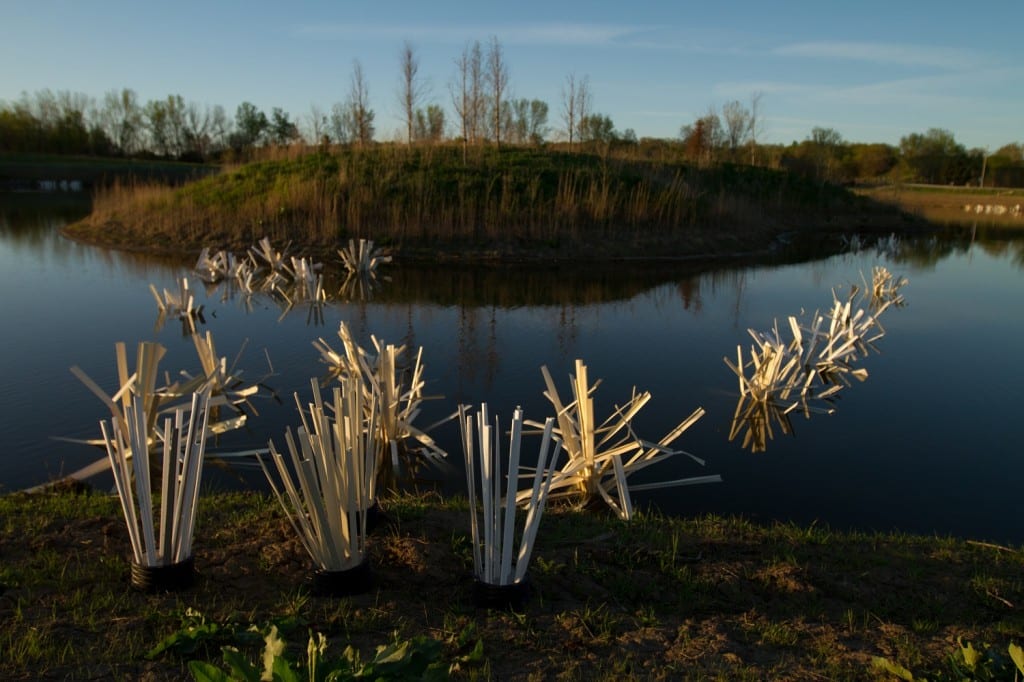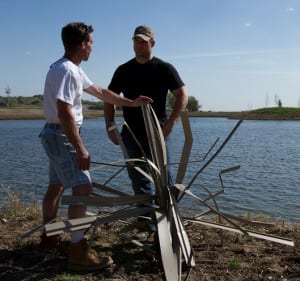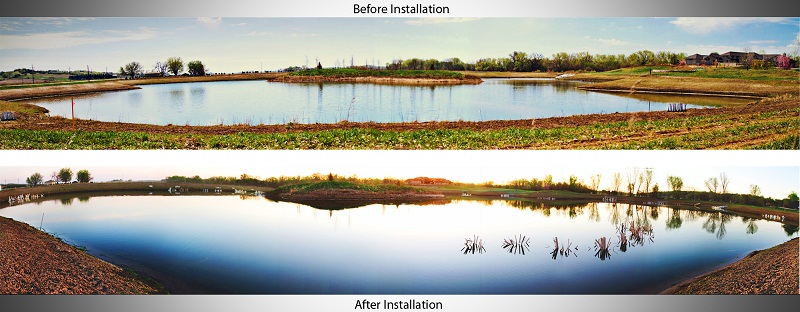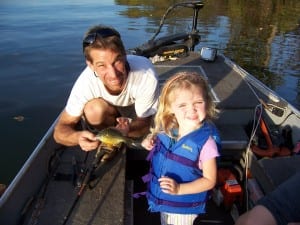| |||||||||||||
Category: kids improving fish habitat
Students protest to protect fish habitat
About 150 Grade 8 students at Samuel Robertson Technical School checked out their usual stomping grounds Thursday, and made a point at the same time.
Protect fish habitat. See the dozens of unique artificial fish habitat models, fish attractors and fish cover used at fishiding.com, the leader in proven science based, fish protection.
The five classes were on an awareness walk in response to changes to the federal Fisheries Act, but also checked out an ongoing stream project.
A control gate on Maggie Creek which flows into Kanaka Creek at 240th Street, helps maintain water levels in the wetlands area upstream, and creates more sheltered habitat away from the main stream.
The project was part of the habitat improvement required when the 240th Street bridge was built a few years ago.
That’s since improved Maggie Creek, confirmed by the presence of a few coho, stickleback and snapper found in the trap during the tour.
Only a few students however commented on Ottawa’s changes to the Fisheries Act now underway which will remove protection of habitat from all streams and just focus on streams of commercial, recreational or aboriginal value.
The phrase ‘harmful alteration, disruption destruction” of fish habitat in general is gone, while the new legislation says no one can cause “serious harm” to native, recreational or commercial fisheries.
Leigh Vivier was one of the few students carrying a Walk for Habitat sign and said he wants to make a difference.
“I want to help save Kanaka Creek – fish, animals and wildlife is at stake.”
He said the trap set in the creek showed that salmon are using Maggie Creek for habitat to stay safe from predators.
“And the number one predator is humans.”
Jade Plul and Alivia Stockall were also aware of the issue.
“We don’t want the fish to go extinct,” said Plul. “We want to save the fish,” added Stockall.
Senior biology teacher at Samuel Robertson Steve Halfnights said the exercise was an “awareness walk” and that many students probably have other concerns.
“For us, we just have to plant the seed and let the students make their choices down the road.”
Ross Davies, with the Kanaka Education and Environmental Partnership Society organized the walk. He helps teach Grade 8 science courses at Samuel Robertson.
He said the changes to the Fisheries Act could threaten the small tributary streams which could be considered neither recreational, commercial or aboriginal fishery.
“In our opinion, it (defining a stream that can be protected) becomes much more subjective.” Under the existing Fisheries Act, protection is automatic, he explained.
The new legislation removes the requirement to get authorization for disruption of any kind of fish habitat. That’s only required for waters that connected to recreational, commercial or aboriginal fisheries.
According to the government, authorization will not be required for projects occurring in waters that do not support the recreational, commercial or Aboriginal fisheries. New tools will be available to manage smaller impacts to recreational, commercial and Aboriginal fisheries.By Phil Melnychuk – Maple Ridge News
Students work for fish habitat
By The Columbian
Pleasant Valley — Students at Pleasant Valley Middle School have become experts at river ecology. First, educators from the Estuary Partnership visited classrooms to teach lessons on river ecology. Then students applied the lessons by donning gloves and boots and planting 1,100 native plants in Pleasant Valley Community Park next to their school on March 12 and 28. These students join a larger partnership of Estuary Partnership and Northwest Wild Fish Rescue working to restore fish habitat in the park. Additional funding for stream restoration was provided by Clark County. See the dozens of unique artificial fish habitat models, fish attractors and fish cover used at fishiding.com, the leader in proven science based, fish protection.
NFL Player Chris Kelsay Tackles Fishing Lake Project in Nebraska
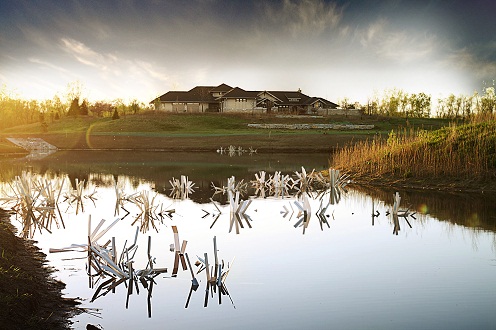
What kind of habitat helps the fish grow large and the water stay clear? Can you actually dictate where to cast your lure to find a bass lurking in the shaded cover like a defensemen reads a quarterback?
If you spend the time and effort to plan the design of your lake or pond from start to finish, you can achieve these goals and much more. Chris Kelsay, veteran linebacker/defensive end of the Buffalo Bills has a passion for more than just football. Chris not only loves to tackle running backs and wide receivers, but big bass are also on the hit list. Growing up in Nebraska, Chris has loved the outdoors all his life. When he’s not playing ball, he’s often talking fishing and hunting with his family and friends, planning his next adventure with his bow, firearms or fishing rods. Chris plays off the field with as much intensity as he does at work, stalking, sneaking and outsmarting his opponents with hard work and dedication.
Another NFL great that is no stranger to the outdoors is Aaron Graham, former Center for the Arizona Cardinals, Oakland Raiders and finishing up his career with the Tennessee Titans. These two guys have quite a bit more in common than playing ball in the NFL. Not only are they neighbors near Gretna Nebraska, but they both love to fish and hunt, having their own private lakes that they enjoy with their families and friends. Both these guys played college ball for the Nebraska Cornhuskers, as well as Chris’ brother Chad. Retiring from the NFL, Aaron now owns and operates his own company called “Premier Outdoor properties”, which specializes in large tract farm, ranch and recreational real estate throughout Nebraska, Kansas, Iowa and Missouri. Participating with Cabela’s Trophy Properties, his firm can help you find your dream hunting and fishing, farm and ranch, lake or river frontage, and large tract acreages, to meet any needs you may have.
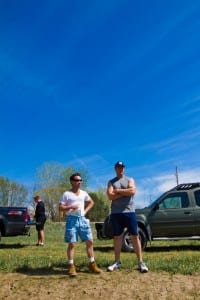
Aaron has had his lake stocked with an exceptional strain of bass, with catches to date over eight pounds by his son Cooper. With the lake being about seven years old, Aaron has a jump start on Chris with some experience in habitat, stocking and water quality. We met Aaron over a year ago, providing him with some of our artificial fish habitat products for his lake. Follow this link to read about aaron’s habitat project. The success he has had with our products, encouraged him to put Chris in touch with the team at Fishiding.com to discuss a plan for his first of two lakes, as it was getting ready to be filled to full pool. With a large well, levelor system, aeration and a stocking plan in place, we came up with a plan and design to meet Chris’ desire to create a personal, one of a kind fishery. The first lake Chris has on his property, at just over six acres, needs plenty of cover for the fish to spawn, hide and hunt within. A well known and respected fisheries biologist Bob Lusk of Pondboss.com, recommends at least 20% of the surface area of a lake or pond be provided in habitat.
See the dozens of unique artificial fish habitat models, fish attractors and fish cover used at fishiding.com, the leader in proven science based, fish protection.
With plans to include aquatic plants, wood and rock, we came up with an array of artificial habitat models to make up about 25% of the needed habitat for Chris’ first lake. We have always felt that a variety of natural and artificial habitat provides the diversity, all types of fish species need to utilize throughout the year. Like most things in life, everything in moderation seems to achieve the maximum efficiency and ultimate benefits for a fishery.
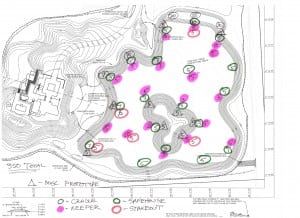
The plan we came up with provided an array of structure textures, sizes and shapes to best provide cover for fish spawning and growing habitats. A total of 350 individual habitat units were hand selected to best achieve Chris’ goals to create a trophy bass fishery. A key element to any habitat plan is to create a line of structure from shallow water spawning areas out to mid depth and ultimately deep water cover. This allows young fry to hide in fine, dense cover immediately after hatching, in the shallow water they are spawned in. As these young of the year fry develop and explore out to mid depth ranges, they need to have cover to utilize as they progress deeper. If this cover is not available, they get eaten before reaching preferred size by predator fish. It is imperative that these small fish are able to hide and grow larger to the 3″-5″ size before becoming forage for the game fish. A bass for instance, needs to eat 10 pounds of forage to put on just one pound in weight. If that bass eats the fry before they get large enough, he will eat them all up just to satisfy his hunger and desire to put on weight.
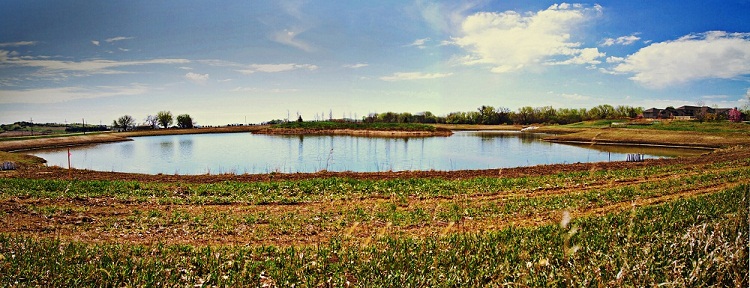
We put our plan together to deliver the structure and help Chris with the installation. Although artificial habitat only needs to be installed once, this was a large amount of structure to ship and install at one time. It was decided we would drive the almost 7200 pounds of habitat out in our own truck and trailer from our facility in northern Illinois. The 475 mile trip had us arriving by lunchtime on a Friday, with the hopes of finishing the installation late Saturday evening, for the return trip on Sunday.
Three of us set out at 4:00 a.m. Friday to achieve our goal. Our son Graham, an electronic media/photography major at Moody Bible Institute in Chicago, came to capture the project in high definition pictures and video and help with the installation process. Also along was our nephew Josh Fick, a starting player for the North Central college football team, over excited to meet and work with the NFL players. Meeting us there was Josh Milczski, a Nebraska native, writer for recycled fish.org, a pond boss moderator and Nebraska Fish and Game board member to lend a hand and share his knowledge. Also on hand to help was Chris and Chad Kelsay, as well as Aaron and Cooper Graham.
We unloaded all 350 units and spotted them around the lake per plan Friday afternoon and then when out for a well desreved Nebraska steak dinner to re-fuel for the big push on Saturday.
The weather was un-seasonably hot, with temps. in the low 90’s and full sun. None of us expected to be getting sun burn in march, let alone starting to find Morel mushrooms already. The turkey were gobbling on the roost as we set up for a long day of work, unfolding each unit and stocking them on the bank near their final resting place. Geese and ducks of all varieties, came in and out of the lake all day, giving us a show of the abundant wildlife in the area. There was about 2 feet of water existing in the lake from runoff and ground water level, an ideal situation to put our plan into motion.
Three Nebraska Boys and one flatlander plan the attack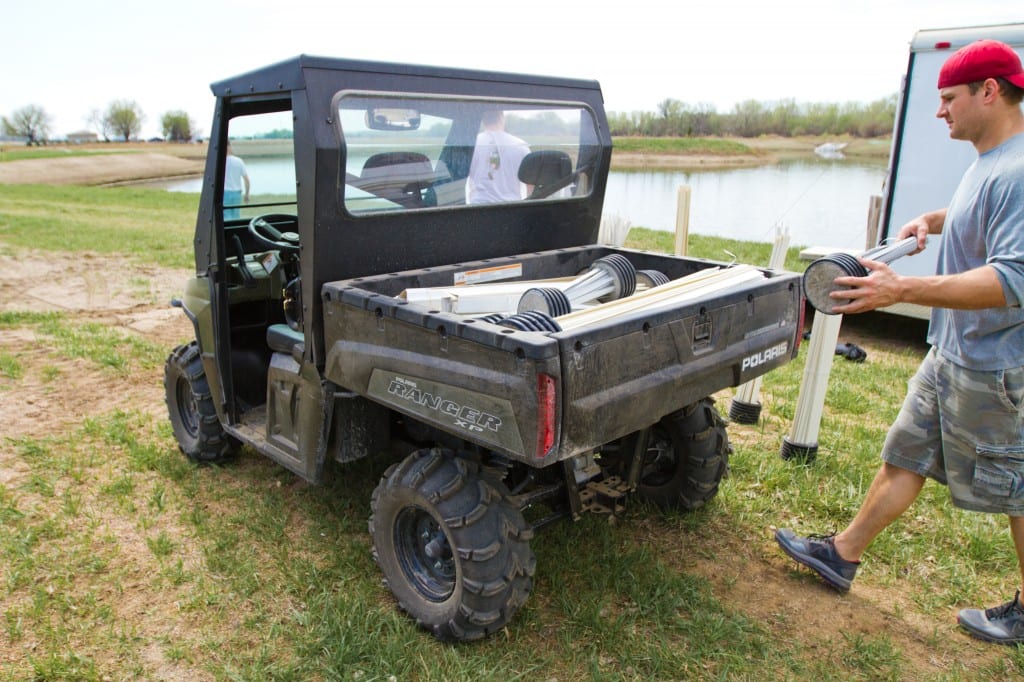
The “Kelsay express” saved lots of time
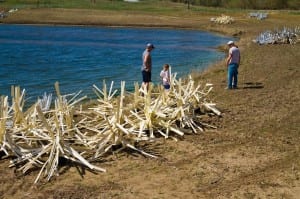
The Fishiding fish habitat products are all made from reclaimed PVC vinyl siding that was destined to be put in landfills. Over 50% of the material acquired has never been used on buildings and will last for many generations to come. This safe, inert substrate, works perfectly for underwater applications in fish habitat. Our main supplier of discarded siding comes from K. Hoving companies. This state of the art waste removal operation currently recycles an astounding 75% of the trash they collect. Re-use is the term they use to explain their company goals. See this story about their firm and the great things they are doing to help our environment. Add the cover and your fish will prosper, Go-Green and save the environment all at the same time.
All fishiding units come complete, ready to sink with no assembly or additional parts/tools needed. Simply open the box, bend to any desired shape and toss in the lake. Each unit sinks upright with the included “stump like” base. There is no incorrect or wrong shape, as diverse as Mother Nature. Artificial habitat products are being used all around the country, as biologists learn more about the many advantages they offer. Years of use from these structures allow anglers and pond/lake owners a snag free habitat for fish to utilize. Saving the environment, these fish attractors help conserve energy with no manufacturing process involved.
Cleaned, cut into various shapes, widths and sizes then cemented into just about any type of safe container, fishing groups are getting involved in creating new habitats lost from degradation and development. All of the fishiding models are available shipped loose as well as in a completed form. Customers can save money by purchasing loose pieces of the PVC in all varities and create their own custom designs by using their own container and cement. A special mixture of cement is also available to ensure a tight, fool proof bond to the vinyl. The pieces and models come in an array of colors, just like the colors available when siding your new home. After the algae and bio film begins to grow, they all take on a greenish/brown appearance.
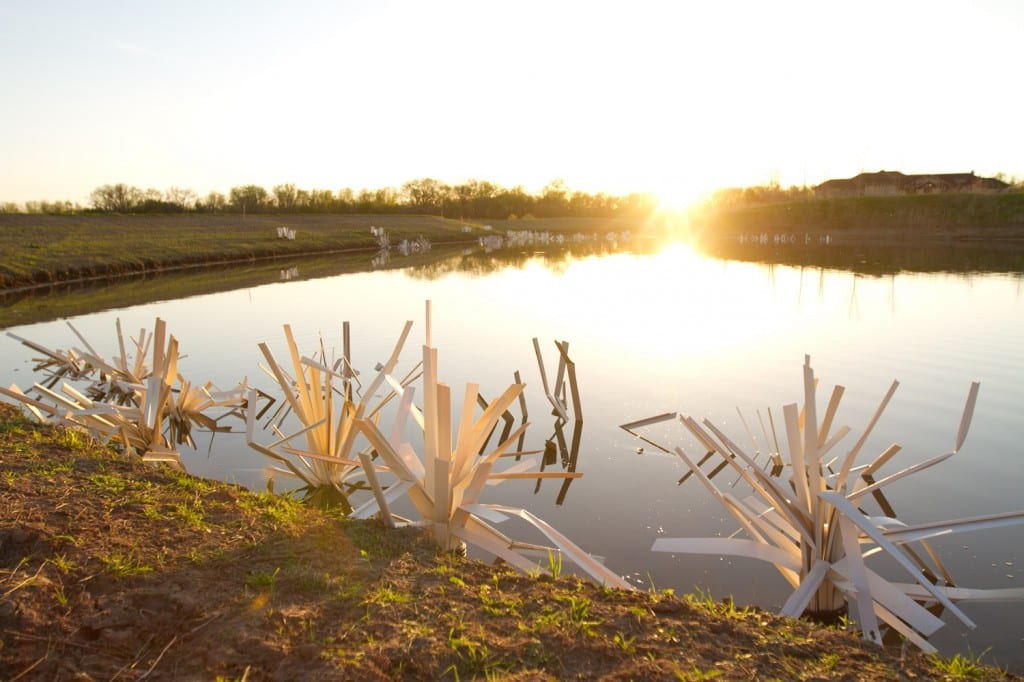
Groups like the B.A.S.S. Federation Nation have begun to incorporate Fishiding habitat products into their ongoing conservation efforts. Projects in West Virginia were recently completed with great success. Plans to work in New Mexico, South Dakota,Virginia and Texas are being put together currently with the conservation directors in those states. The B.A.S.S. Federation Nation leads the industry by example in conservation work with groups in all states and Canada promoting conservation and water quality issues world wide.
Lake and pond owners enjoy the ease of installation, with no need to ever replace. The limbs all have any holes or notches removed to make each unit snag resistant,unlike brush and Christmas trees. By providing shallow habitat for fry and forage fish, mosquitos can be almost eliminated in the area, as they feed on these pesty critters. Shallow habitat is the key to growing your own forage base, thus eliminating the need to constantly restock minnows to feed your game fish.
100 Keeper models were incorporated into the plan for deep water structure. These large units each boast over 62 square feet of surface area and allow predator fish to hunt and hide around. When opened and bent to shape, they cover a seven foot diameter and are best installed with about a foot of space in between. This allows fish to navigate through them, feeding and resting in the shade they produce. Bass prefer the dense cover and shade that these fish attractors provide.
Also part of the plan was to install 25 Stakeout structures, which are artificial stake beds, crappie and bluegill fisherman use a great deal in the south. These units stand 48″ tall and have an open grouping of individual “sticks” that the panfish prefer. Another 50 smaller prototype versions of these were installed in shallow areas for young of the year fish to navigate through as well.
See the dozens of unique artificial fish habitat models, fish attractors and fish cover used at fishiding.com, the leader in proven science based, fish protection.
With all the help and planning, we were able to meet our goal and finish installing all 350 Fishiding habitat units by sundown on Saturday. Chris welcomed us into his beautiful home and surrounding landscape. Although we had no time to hunt or fish while we were there, plans are being made to come back to install our habitat products in his second, five acre lake. With common goals of preserving our natural surroundings and creating a fantastic fishery, we are planning to spend some time together in the great outdoors with bows, guns and fishing rods in hand. New friendships have been made, stories of the hunt continue to be shared and the love of the great outdoors continue to be the catalyst for a common bond between men from all walks of life.
Volunteers brave the cold to create fish habitat
| ||||||||
GRAFTON — A large group of volunteers faced the bitter cold Saturday morning as they gathered at Tygart Lake to anchor recycled live-cut Christmas trees for future fish habitat.
The program started in 2007, as the United States Army Corps of Engineers at Tygart Lake sent out the call for Christmas trees in December. Each year since, the number of donated trees, and the number of volunteers to anchor them, has grown substantially.
See the dozens of unique artificial fish habitat models, fish attractors and fish cover used at fishiding.com, the leader in proven science based, fish protection.
Residents are encouraged each year to drop their live-cut Christmas trees off at the Grafton City Garage after the holiday season. The city then transports the donated trees to the lake, where they are distributed by volunteers.
“This has been a record year for trees and for volunteers,” stated April Hawkey, Tygart Lake Corps of Engineers Park Ranger. “I had an assistant from WVU (West Virginia University) hand out fliers on campus for volunteers. The WVU Fishing Club called and asked ‘how many people do you need?’ that was great, in calling for volunteers, you never know just how many you will get.”
Hawkey stated that 15 volunteers from the club came out to assist with the effort. Along with the fishing club, regular volunteers, who have made this a regular project since the beginning, showed up in force. These regulars are from Boy Scout Troop #6 from Grafton, and the Save The Tygart Watershed Association.
In all, 45 volunteers helped place the trees near the site of last year’s donations.
During what was obviously one of the coldest mornings in February, these brave volunteers met for orientation at the Corps Park Office at 9 a.m.
From there they traveled down to the gravel lot launching area where 400 donated trees awaited. Each tree had to be anchored to concrete blocks strategically located to put the trees about15-20 feet underwater at summer pool levels. Each tree had to be drilled at its base to allow for the zip tie used to attach it to the block.
Volunteers arrived to find the trees awaiting at the top of the launching area. Together they threw, rolled and dragged the trees down over the hill to the staging area below. With Fish Attractor buoys attached, anglers will know where to go to take advantage of these efforts.
The donated trees are anchored along the Tygart Lake shoreline in February, while the lake level is low, so that when the lake returns to its summer levels the trees act as artificial reefs, providing advanced habitat for the lake’s fish and improved fishing opportunities for anglers. Once secured on the lake bottom, the Christmas trees provide shade and a hiding place for fish.
As Hawkey ran the crew up top, making many journeys up and down the steep hill, US Army Corps of Engineers Tygart Lake Resource Manager, Mike Estock handled the efforts down the hill at the staging area.
The success of this program has been noted in various fishing publications. One such mention comes from an April 25, 2010 report at sportfisherman.com, which expands upon the success of the project. “The lake (Tygart) is near the summer pool level. Target largemouth and smallmouth bass by casting crankbaits along the shoreline. Crappie are now concentrated around Christmas tree fish attractors. There are lots of walleye and trout in the tailwater and this is the best place in northern West Virginia to fish for them.”
Trees were donated by Lowe’s, Home Depot, Barbour County, and the cities of Grafton, Nutterfort and Morgantown. The Corps’ staff at Tygart Lake would like to thank those who donated the trees, WV DNR for their cooperation, and all of the volunteers for assisting in the construction of the fish attractor.
After the event, all of the volunteers were treated to pizza. Hawkey also stated that a volunteer appreciation day is in the works, for everyone who helps make Tygart Lake State Park a wonderful place to visit.BY: Matt Trout
Do your kids like to fish and be outdoors?
Have you started making summer plans yet? Well, if you have a youngster who is into fishing and all things outdoors, there is a great opportunity available.
The New Jersey School of Conservation in Sussex County will be the host site for a Coldwater Conservation School offered by the state Division of Fish and Wildlife and the N.J. State Council of Trout Unlimited. The School will be held June 28 to July 1 and is open to kids ages 11 through 14 at the time of the program.
This is an interesting experience that combines fun and learning. The goal of the school is to foster knowledge and appreciation of trout and the cold-water habitats on which they depend, basically helping kids understand what role they can play in conserving the habitat.
Division of Fish and Wildlife biologists and instructors from Trout Unlimited will teach sessions about stream ecology, fish habitat, fish biology and identification, aquatic insect identification, fly-tying, fly-casting and stream restoration. There will be evening programs where students will learn about reptiles and New Jersey’s black bears.
See the dozens of unique artificial fish habitat models, fish attractors and fish cover used at fishiding.com, the leader in science based, proven, fish protection.
The cost of the Coldwater Conservation School is $200, which includes food, lodging and equipment for four days and three nights.
Applications are due no later than April 1. Students accepted into the school will be notified by the end of April. The school was very successful last year with more than 30 applicants, so the folks running the show urge you to get the application in as soon as possible.
If interested, you can find more information and an application at state.nj.us/dep/fgw/pdf/2012/conservation_school_application.pdf, or call Jessica Griglak at 908-637-4125 or email at Jessica.grigla@dep.state.nj.us.
TALKING TURKEY: The Pequest Trout Hatchery and Natural Resource Education Center will host a turkey hunting seminar at 1 p.m. March 10. Learn about the state restoration program and how to hunt this prized game bird.
The New Jersey Chapter of the National Wild Turkey Federation will host a turkey call clinic immediately following the seminar. Registration is not required for the seminar or clinic.
FOR THE BIRDS: Here’s something different, courtesy of the Pequest Trout Hatchery and Natural Resource Education Center. Friday is the 15th annual Great Backyard Bird Count, taking place from 10 a.m. to 4 p.m.
Bird watchers of all ages are asked to come and count birds to create a real-time snapshot of the bird population. Participants can pick up a tally sheet of bird species potentially seen there at this time of year.
Plan to count birds for at least 15 minutes, but you can go longer if you wish. Count the greatest number of each species that you see together at one time. Count in as many places at Pequest as you choose, and keep a separate checklist for each location.
When finished, submit your results to the staff member at the front desk.
Your data will be entered.For more information, log on to birdsource.org/gbbc/whycount.html.
By MARK J. CZERWINSKI
Kids learn to improve and protect habitat

Photo: USFWS
Schoolyard Habitat Program
 The Schoolyard Habitat Program helps teachers and students create wildlife habitat at their own schools. Typical projects include: wetlands, meadows, forests and variations based on specific ecoregions.
The Schoolyard Habitat Program helps teachers and students create wildlife habitat at their own schools. Typical projects include: wetlands, meadows, forests and variations based on specific ecoregions.
Many projects are planned through multiple phases and change over time as children from various classes build upon the existing work of past students.
We work with your school to provide:
- technical assistance and project guidance
- teacher training,
- develop written materials
Our goal is to provide technical and organizational assistance to school, so they can create outdoor classrooms that are effective as educational tools in addition to being a sustainable habitat for many years to come.
Please download the following Fact Sheet for more information on the Schoolyard Habitat Program:
Schoolyard Habitat Fact Sheet (.pdf)
Hoping to lure a new generation, Iowa restocks its fishing holes
ISU student Dan Taylor shows off two rainbow trout he caught near the dock at Ada Hayden Heritage Park Lake in Ames after the Iowa Department of Natural Resources stocked about 2,200 11- to 13-inch rainbow trout from a hatchery in Decorah, Iowa, on Friday November 19, 2011, in the north basin of the lake. / David Purdy/The Register
A whole stringer of folks are working to make sure Iowans can catch fish close to home.After all, the Iowa Department of Natural Resources figures, people are busy.
Gas prices are high. And if someone doesn’t get kids interested in fishing, and by extension, water quality, who will lead the push to clean up Iowa’s already troubled waterways in the coming decades?
The DNR has joined local and federal agencies and fishing clubs across the state to install new fish habitat in many lakes, some of which also are being stocked with keeper trout. Such urban fishing spots as Big Creek Lake, Easter Lake in Des Moines, Blue Heron Lake in West Des Moines and the pond at Des Moines Area Community College’s Ankeny campus are getting dredged, protected by siltation basins, or dotted with artificial reefs, for example.
See the dozens of unique artificial fish habitat models, fish attractors and fish cover used at fishiding.com, the leader in science based, proven, fish protection.
The state also is stocking trout in lakes near cities, and hybrid bass in gravel pits.
DNR surveys show most people fish within 20 miles of their homes, if they fish at all.
“We want kids to be able to walk or ride their bikes somewhere to fish,” said state fisheries biologist Ben Dodd.
Local fisherman Dave Merical of Ankeny has worked on many of the projects. “People don’t want to drive forever to fish,” said Merical, a leader in Central Iowa Anglers, a private group helping with the work. “We want people to have a good experience close to home. Kids are the future stewards of the resource. If they don’t enjoy fishing they aren’t going to want to take care of the waters.”
Joe Larscheid, who runs the state fisheries bureau, said fishing is one way to lure Iowans outdoors.
“It’s a nationwide epidemic,” Larscheid said. “It’s the Xbox generation. Kids are comfortable sitting in front of a computer and doing Facebook.” He’s working with health officials on a program called “Take It Outside” to encourage outdoor activities.
“Our initiative is to get people outside,” Larscheid said.
“Fishing is a gateway. When people are outside, they are more engaged with the environment and they are more likely to support conservation.”
There’s some ingenuity in the new initiative. Central Iowa Anglers and other groups are helping the cash- and staff-strapped DNR by providing materials that can be placed in lakes for fish habitat, giving catfish and other species somewhere to spawn.
So discarded pallets become makeshift underwater teepees, Merical said. Plastic pipe is formed into the shape of a tree. Cedar trees growing where they don’t belong are cut down, weighted down with cinder blocks, and dumped in the lakes to shelter fish. Barrels, too.
“The cost is insignificant because we use volunteer labor to do work the DNR approved and wanted done anyway, and the materials generally are donated,” Merical said.
The Des Moines area is getting the most attention in the early going, with work at Easter Lake , Blue Heron Lake, Lake Petoka in Bondurant and Big Creek and Saylorville near Polk City.
The U.S. Natural Resources Conservation Service and local soil and water conservation districts help by persuading farmers to conserve soil and carefully target chemicals they want kept out of waterways
One of the most popular parts of the program is the stocking of 10- to 12-inch rainbow trout in 16 lakes around the state.
The DNR announces when the 1,400 to 2,200 trout will be released in each spot, often drawing hundreds who hope to catch and eat the fish before anyone else does. The fish are raised at the Decorah hatchery.
It isn’t exactly shooting fish in a barrel, but the trout are very easy to catch, Larscheid said.
Usually, anglers catch all the released rainbow trout within two months, Larscheid said. It’s supposed to be easy. The idea is to get kids interested in fishing, and excite urban-dwellers about a sport that has produced flat license sales of about 300,000 a year.
Iowa has naturally reproducing brown and brook trout in some of the cold-water streams flowing through northeastern counties. But lakes contain only stocked trout. If they aren’t caught before temperatures rise, most of them die.
Ice fishing is big in Iowa, particular at places such as Clear Lake in north-central Iowa and the Iowa Great Lakes in Dickinson County in northwest Iowa. In the Des Moines area, biologists will release trout in both Lake Petoka and Ada Hayden Heritage Park Lake in Ames through the winter ice this season.
Iowans need a $12.50 trout stamp in addition to a fishing license to fish for trout. A resident fishing license costs $19. Children under age 16 can fish for trout without a license or stamp if they are with an adult who has both.
Dodd said the state also is experimenting with stocking hybrid striped bass, known as wipers, in gravel pits and ponds near cities.
They’ve been stocked at Saylorville Lake north of Des Moines for years, but have a reputation for being hard to catch.
They also don’t reproduce, and often get flushed through the spillway during floods. So it’s hard to keep the population up, Dodd said.
www.iowadnr.gov/Fishing/TroutFishing.aspx
Stillwaters Environmental Center for fish habitat enhancement gets it done
Olympic Fly Fishers of Edmonds plan Dec. 14 fund-raising auction
The Olympic Fly Fishers of Edmonds are hosting their annual dinner/auction Wednesday, Dec. 14th, to raise funds for a variety of conservation programs. The event begins at 6 p.m. at the Edmonds Senior Center. See the dozens of unique artificial fish habitat models, fish attractors and fish cover used at fishiding.com, the industry leader in science based, man made and artificial fish habitat, proven to provide all fish with cover they prefer to prosper.
Last year’s dinner raised more than $4,000 that was used to support the Western Rivers Conservancy, an organization that focuses on the purchase of critical stream and estuary habitat; the Coastal Conservation Association of Washington, a grassroots organization that advocates for fish and fish habitat; and Long Live the Kings, which works toward restoring wild salmon to Pacific Northwest waters.
Last year the club also donated funds to the Stillwaters Environmental Center for fish habitat enhancement and is currently working with the Edmonds School District to encourage teachers to incorporate fish conservation into elementary school science projects.
This year’s auction will include a traditional live auction for a number of guided fishing trips, fishing equipment and an estate planning and will development session with a local attorney. The silent auction portion of the event will feature a large assortment of fishing-related equipment, outdoor clothing and gear, and raffle tickets will be sold for a chance to win gift baskets, books, wines, a barbecue grill and other items.
Tickets for the dinner are $50 per person. For more information and ticket-reservations for the dinner auction, contact Dave Gross at 425-582-7290 or by email: gross1@illinois.edu.


